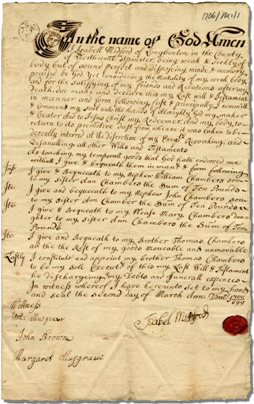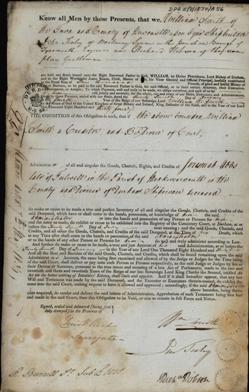A Brief Introduction to Probate Records
Probate is the process of proving a will and of administering the estate of the deceased. This process is today undertaken nationally by the civil courts, but before 1858 probate business in England and Wales was administered in the main by ecclesiastical courts in a system of provincial, diocesan and special jurisdictions. In the natural course of several hundred years of this work substantial probate record collections have accumulated in various registries and archives. Durham University Library today holds the probate records of some seventy thousand individuals from County Durham and Northumberland - the old Durham diocese - who lived between the early 16th century and the mid-19th century. Making these records available online and for free now offers to historians and genealogists an unsurpassed opportunity for study and discovery. With the support of the Heritage Lottery Fund, English Record Collections, Durham University and the Genealogical Society of Utah the North East Inheritance project has catalogued and digitally photographed the Durham diocese probate collection (1526-1858).
Wills
While only a fraction of society left probate records that survive today, those that did have bequeathed to us a treasury of history. The most familiar record to us is the will, by which a testator declares how his property is to be disposed of after his death. Although these records are often simply schedules of relatives and assets, wills can offer a colourful and detailed narrative of a time and a life lived.
The value of wills particularly to family historians can not be understated. Close reading can uncover familial and economic networks as well as information about property, indebtedness, domestic arrangements, religious conviction and education. A testator having died, in order that his wishes might be carried out lawfully his executor would first have to validate or 'prove' the will and obtain a grant of probate from the court. If the deceased died intestate, without having made a will, then the next of kin would obtain a grant of administration. Both such grants enabled the executor or administrator to begin to distribute the goods according either to the terms of the will or to the laws of distribution. These grants of representation required the appointed representatives to enter a bond, an inventory and finally an account, although sadly inventories and accounts are not commonly found in the Durham collection after 1700. |
 |
|
Will of Isabel Mitford of Longbenton, naming a sister and three nephews and nieces, to whom she bequeaths £30, the residue passing to her brother.
Ref: DPRI/1/1706/M1/1. |
Probate Bonds
As a safeguard against maladministration or unreasonable delay executors and administrators were required to enter into a penal bond in which they bound themselves to act faithfully and as proof of this to enter an inventory and finally an account. The bishop was indemnified against any maladministration by the financial penalty the value of the bond represented, usually twice the value of the estate.

Administration bond for the estate of Jeremiah Abbs, a ship-owner of Fulwell. The administrator is a creditor of Abbs' named William Smith, a shipbuilder of Newcastle upon Tyne.
Ref: DPRI/3/1834/A56. |
 |
|
Probate Inventories
Such inventories list the goods and chattels of the deceased, and often describe the household contents room by room. As well as clothing and other household items, inventories can list detailed valuations of farming crops and stock, shop goods, and can reveal debt and credit networks and even details of funeral expenses.

Inventory of John Hylton esquire of Hylton Castle, on this page listing the contents of the kitchen, hall, dining room, great chamber, baron chamber and the blue bed chamber. Among the goods are a brass clock and a milking pail.
Ref: DPRI/1/1674/H13/3. |
 |
|
Probate Accounts
Probate accounts were submitted as a final record of the often long process of winding up the deceased's affairs, and when they survive these can provide a narrative of debts received and paid, and occasionally offer a glimpse of domestic and business affairs of the deceased's estate during the months it lay in administration.

Account of the administration of the estate of Alexander Selbie esquire of Biddlestone, entered by his widow and administratrix Joan Selbie. The account names eleven creditors and more than ten servants who were owed their wages.
Ref: DPRI/1/1632/S1/1-2. |
 |
|






